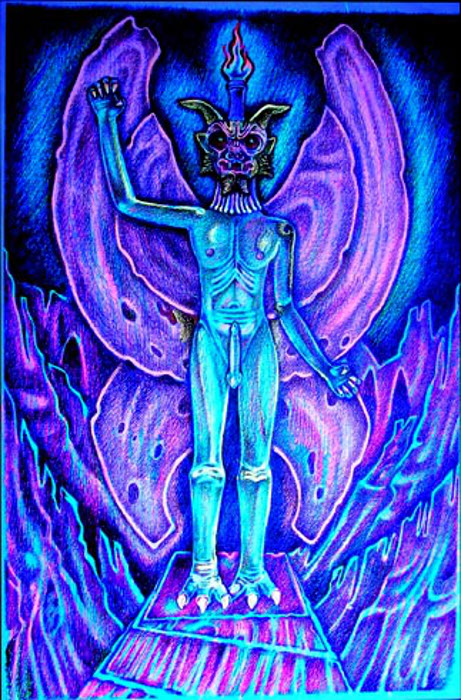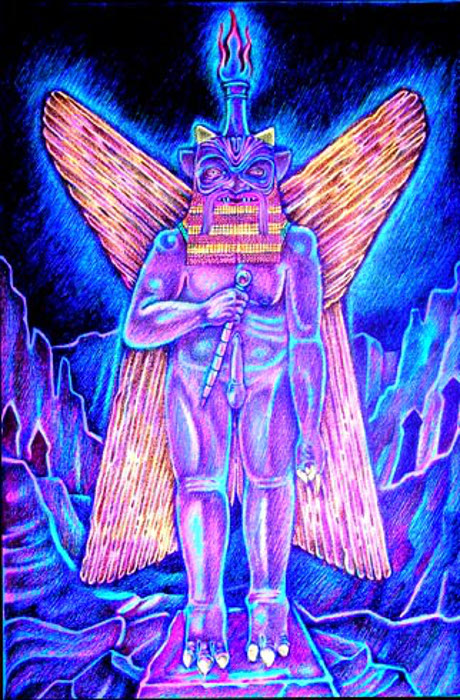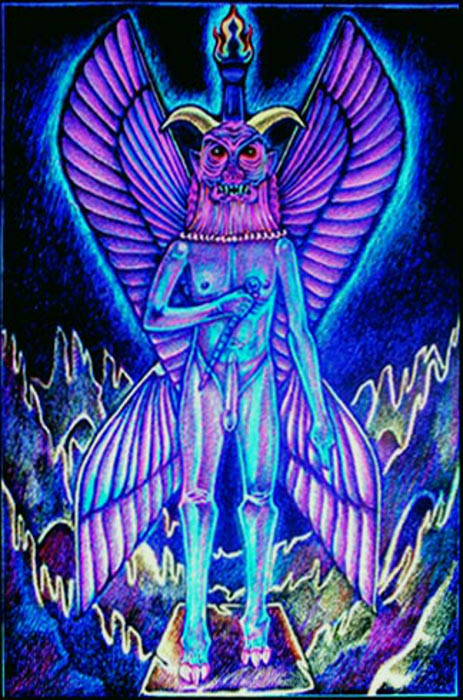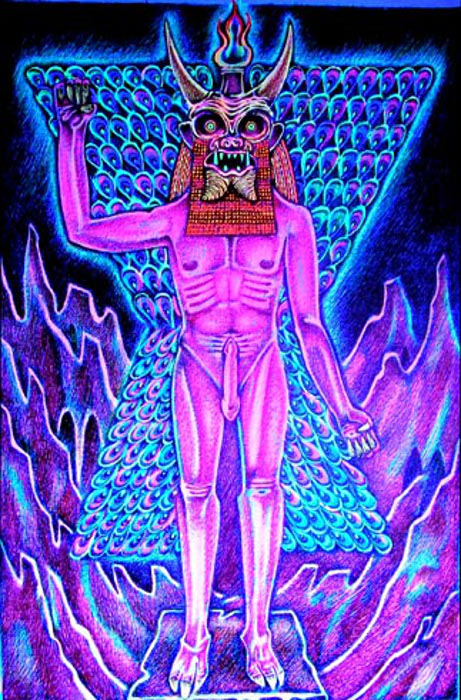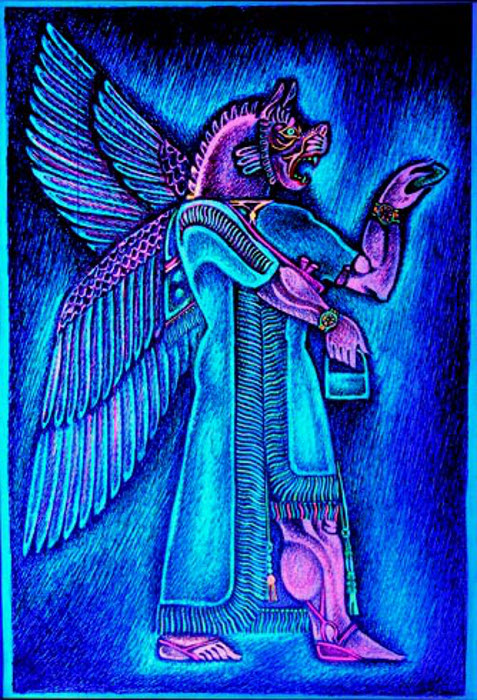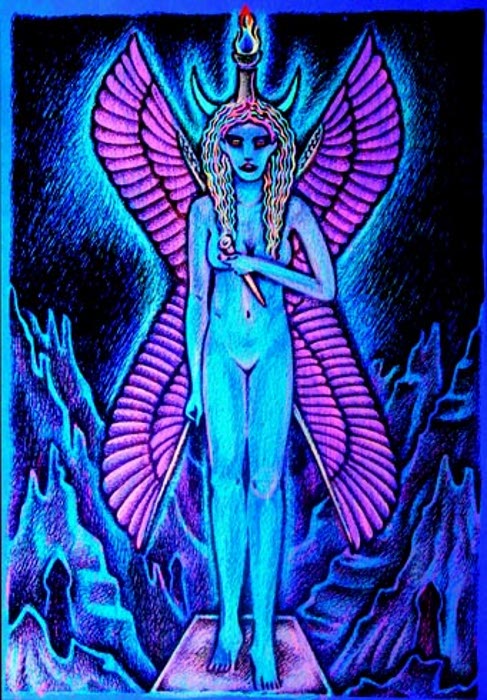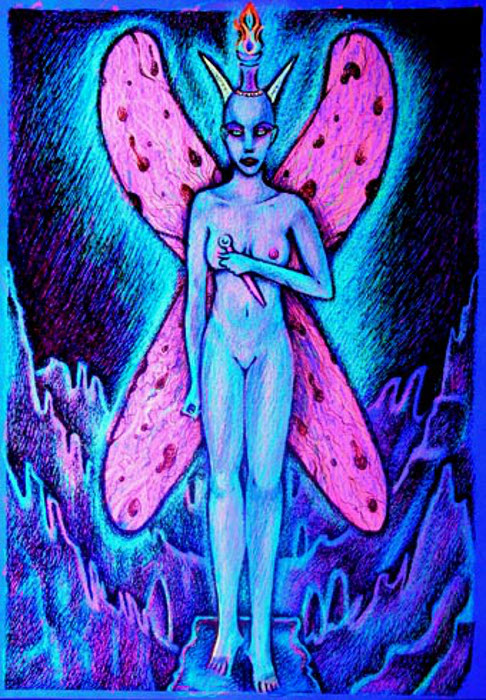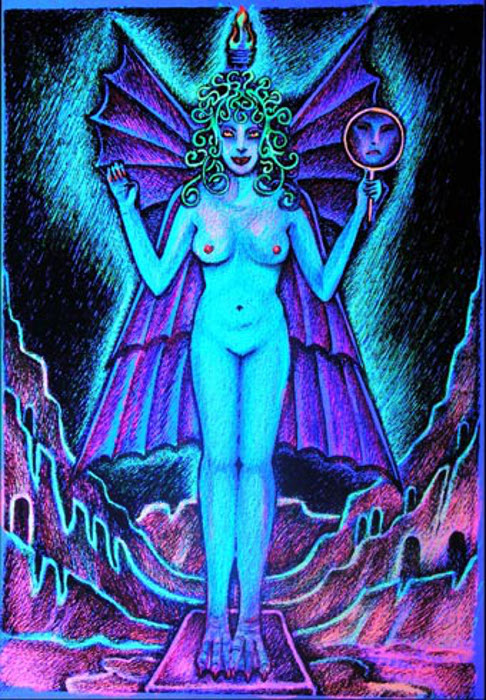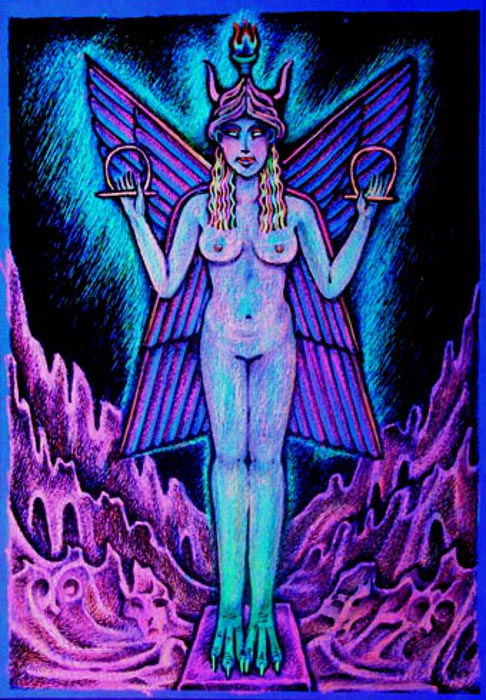PAGE 2
KINGS and QUEENS of the UNDERWORLD
***ALL ARTWORK AND LITERATURE COPYRIGHT: CHRISTOPHER TEMARES
KINGS and QUEENS of the UNDERWORLD
The literature
and artistic expression handed down to us from the ancient peoples of Sumer,
Babylonia, Assyria, and the other occupants of Mesopotamia from about 3,000
B.C.E. demonstrates a great importance in the belief in spirits both beneficent
and malevolent in nature. Along with amulets in the forms of stones, plaques,
tablets, and cylinder seals, they employed the use of magical figures, usually
buried beneath the doorposts or foundations of a house to protect the inhabitants
from the demonic forces so present in that region. These timeworn artifacts
give us a glimpse into the soul and consciousness of the believer, so real
these mysterious forces proved to be. Nowadays, such beliefs are shrugged
off as primitive superstitions. To examine from a broader point of perspective,
however, in relationship to events and time, even the most secularized eyes
and technologically adept minds cannot fail to recognize the brutal truths
these personifications of our hidden realities are for certain to reveal. |
PAZUZU:
In the British Museum are several examples of a peculiar figure, one of which been catalogued by Sir H. Laylard 'Number 93089'. It is rendered in bronze and depicts the head of a monster whose eyes are round and fierce, and the shape of its mouth, gruesome in its expression, show that it is in the act of growling or roaring.
The same creature is featured on a series of plaques, one at least which was introduced by M. Pe`re`tie in 1879, acquired by De Clerq, and published by Clermont Gannuae in the Revue Arche`ologique (l`enfer Assyrien) in December of that year.
The demon is of a frighteningly terrible aspect and seems to have been used in a rite of exorcism against the baleful influence of the storm goddess, Lamashtu.
The name of this animal demon is Pazuzu, and an inscription published by Thureau Dangin (revue, p. 190) deciphers him to say, "I am Pazuzu, King of the Air Devils, Son of Hanpu. I goeth forth from the mountains raging like a whirlwind!"
Although any significant mention is lacking, inscriptions and cylinder seals seem to suggest Pazuzu was synonymous with those forces of Chaos so dreaded by the Mesopotamians even though his unique powers were necessarily utilized in the rites of exorcism. When the goddess Innana/Ishtar returned from the grim abodes of the underworld, She was accompanied by some of its shades, demons, harpies and ghosts. Pazuzu was therein a watcher in the Place of the Seven Gates.
Just as the resurrection of Spring and its fecundicity had thus been reborn, so through the opening of the gates of the abyss did pestilence and plague creep forth.
On a cylinder seal in the British Museum, catalogue Number 103317, a scene depicts the god Ea condemning the demon who stands before him in the presence of several other deities.
It is ironic that such a pestilent force would have been invoked for the safety of women in the labors of childbirth and even more remarkable that Pazuzu's reverence should have quickly spread even into the land of the Nile and further south still into the land of Abyssinia.
A very old example of this demon is probably the same as that which is depicted on a pre-dynastic Egyptian throwing stick in the British Museum, Number 18175. It dates from that period of Egypt when the storm god, Set was still widely venerated there. By the 19th dynasty, the god, Bezu was oft represented as a jolly gargoyle type of creature, semi-human, and a protector of women in childbirth. But his aspects also took on a ferocious form.
In several versions of the Book of Gates, he is a guide in the underworld much in the same way he functioned as a gate watcher in his Assyrian aspect. In his most outward form, however, the god of pestilence and disease manifests in the roar of locusts, the madness of war and the insanity of demonic possession.
|
BAAL: The original meaning of the god's name as Baal is generally accepted to have meant 'Lord' or 'Overseer' and by the many tribes of Canaan the term was applied to their chief gods. To the Mesopotamians, Bel was equated with Enlil, the primary god of earthly kings. To the Israelites who entered Canaan after the Exodus, Baal became the terminology of 'Adversary' and they used it to describe any 'alien' god, or False Idol, as it is referred to in their bible. The most renowned Baal, however, was when He was associated with the thunder god, Hadad, a violent deity of rain and fertility. He lived in a mountain in the north of the region and was known as 'Lord of the North,' Baal Xaphon. It was Baal who proposed the creation of humanity from the mud of the Earth mixed with the blood of Kingu so that men would be the servants of the gods. But growing weary of the noise they made as their numbers grew, He came down upon them as a great deluge. Threatening humanity with storms of war and plague, He is Baal Zebul, 'Lord of Flies' or 'King of the Locusts.' |
|
Baal, after His defeating the forces of chaos which would subdue Him, had become a symbol of pride and brutality. In this regard, He is the god that 'does not kneel. ' Invocants, when calling forth the mighty Baal, face the North for the destruction of enemies or in situations that beckon unyielding aggression. It may also be noted that the similarities
between this god and the Egyptian Set, or Sutekh, are probably not coincidental. |
|
|
KINGU: The ancient demon of primordial chaos, Kingu, was either the son or consort of Tiamat. According to texts, the Human race was created by mixing the mud of the Earth with Kingu's blood. Like the other chthonic deities of His time, He was cast into the depths of the Underworld. He is invoked from the West. Kingu is depicted as a ferocious dragon, sharp of tooth and merciless of fang. The lashings of His tail cause tempest and quake and He presides over all children of pride and rebellion. In His most terrible aspect, He is the anathema of both gods and humans. His likeness becomes obvious in the manifestation of nightmares, dragons of sparkling intensity-'Shining of Scales' ... tempest demons and savage dogs, furious storms, gorgons and ram headed monsters. In the beginning or before it …He was the Keeper of the Tablets of Destiny. Because all sentient beings were created with the blood of Kingu, there is no doubt that within the far reaches of the sub-consciousness' hidden underworld, the demon crouches in wait. |
Perhaps it is to be recognized in the most 'primitive' faculties of the mind or the very physical limbic system of the brain's interior. On a cosmic level, there is ample evidence that extremely dense fields of matter and anti-matter produce what is called an 'Event Horizon' that literally bends space and time, consuming all things, even the very light which dares enter its domain. |
|
Molech: Molech was the name given to the god of the Ammonites, a people who flourished in the southernmost regions of modern Jordan. They may have been descendants of the biblical Lot in the cities of Gomorrah where the goddess Qedesha was worshipped in Her magnificent fire temples. It has been suggested that at the valley of Gehennom, the children of ritual prostitution were sacrificed by being cast into the flames at a temple in Topeth. It is more likely that this ritual was, in its purest form, an initiatory rite practiced by the priestesses of the temple. As Adramalech, He is known as 'King of Fire' and His symbol, in keeping with millenniae of tradition is the peacock. The name, in Buddhist lore, is a paraphrase for the Devil. Hebrew legend, however, relates to us that King Solomon built a temple to Him with the help of the Djinn. A very interesting and reliable script has been written by LaVey in his chapter "Pilgrims of the Age of Fire." |
|
As the idol of the Yezidis, a small band of heretics whose sanctuary lies situated on Mount Lalesh near the ancient site of Nineveh, Melek Taus, the Peacock King is the symbol of pride par excellence and this may have a lot to do with the unique heritage they see as their own. Unlike their Christian and Moslem neighbors, they reject the notion of being descendants of Adam, but reckon themselves the children of Azazel. In the secluded confines of the sanctuary, the god in His form of this magnificent bird is placed upon the sanjack, surrounded by a living pool of water fed by the subterranean Well of Zam-Zam, or as the kings of old Assyria would say, 'the Sweet Waters of Apsu.' In more remote times such ceremonies as were performed in the cities of Bethel, Gilgal and Beersheba, priestesses were employed in the temples wherewith their devotees they indulged in licentious rituals. It is not unlikely that Isiah, the so called prophet, fathered a second child in one of these shrines having coupled with a 'zonah,' a temple priestess, for such a ritual purpose. There is some speculation that Molech may be identical to the god worshipped in Tyre and Carthage, Baal-Ammon and this comparison is more than likely correct. With offerings of wine, fire and incense, Molech in his most exalted manifestation is invoked from the South.
|
Rimmon
Rimmon was a name given unto the Assyrian lightening god, Barku, and whose name in Akkadian was Im. As an Aramaen deity, he was worshipped in Damascus and was also idolized in biblical Syria. To the Babylonians he was the roarer armed with a trident.
It seems only practical to conclude that Rimmon, ‘The Roarer’, was already a very ancient principality to the priesthoods of those epochs going far back to the earliest beginnings of old Sumer and perhaps Elam.
It is known that Innana/Ishtar’s journey into the underworld placed her in the company of the Seven Judges who crouched at the gates therein, whose eyes were the look of death.
Rimmon, it seems, was amongst their court.
Originally, this company of djinn dwelt in the mountains and less traveled paths, some in streams and wells, others in holes or caverns much as they do in modern times. For a period of time, however, their worship was widespread, until at last the paths of men’s hearts began to tread different destinations and the djinn returned to their underworld stations crouching in wait at the crossings.
QUEENS of the UNDERWORLD
The ancient trade routes that wind across the jagged desert terrains of Mesopotamia and Elam have long ago been silenced by Time and the nature of events; The paths of men's hearts have gone onto other places of Paradise.
Once along these old highways, roads far less traveled today, the caravans of Lapiz-lazuli made their journeys between East and West, a pioneering spirit abundant in tales of gods and secret treasures in the Earth.
These deserted grottos and isolated haunts were once the epitome of flourishing fertility rites and retinues of indulgence.
They are quiet now, but never dead…only dreaming.
Some of them, for lack of homage, have become grotesque in their appearance, their once lush offering tables now covered with the dust of lethargy and wanting in their abandoned underworld niches.
But, by nature their illumination is magnificent and overpowering. Only centuries of neglect have rendered them otherwise. As but dormant seeds of plenty, fallen to the Earth, They await, crouching at the gates of Invocation.
ISHTAR:
Well before the worship of the many gods had become manifest and the cities which propitiated them had yet to rise with their majestic ziggurats, the mystery of birth and fertility recognized a divinity in which the feminine element predominated. She represented the reproductive powers of the Earth.
With the enlightenment of Humanity's power in relation to Nature, and with the establishment of agriculture and domestication came an understanding between man and his Mother Earth.
And when he became wise about the paths of the stars and their appointments with Destiny, he beheld this as Her language.
When She arose again from the abyss of the black chaotic Night as the Morning Star in the East, Her name was Innana/ Ishtar.
For it was She who had returned from her dreaded journey through 'The Land of No Return' seeking Her lost lover.
"She illuminates the Wise who before were non- believers. And to the god-kings of the Earth, She bids them to love but serve lest calamity and tribulation befall them.
"Her gift is all the world's delights, but Her wrath is brutal.
"Greater princes of the world than all the ones we know have borne witness and would reckon us the Un-wise in our arrogance and folly."
"Passion," says She, " in both Love and War, for they both lead up to one another. In the course of due Time."
ERISKIGAL:
To the House of Dust go lord and priest.
Within the Heart of Darkness shall dwell the wizard and the prophet.
'The Land of No Return' is the place where falls the Star of Lamentation, and at the passing of each the Seven Gates another vestige of light is cast away.
Her name here is Erishkigal. She is the thief of loved ones, the anguish of the Heart in Seeking. Her sincerity is forever dread and remains motionless in the Void.
"You'll find no mercy, no salvation here within these walls, but the Truth."
"My azure eyes are the Look of Death in this grim abode. This grim abode that awaits every soul that is born. Neither the rich nor the beggard have a moment to waste. Neither the wicked nor the innocent even have a prayer. None escape!"
"Hear, O living, the Truth revealed…
"When your time has come and your life passes, for a while you shall be lamented. In due time, however…
"Therefore..."Drink and celebrate the sweet wines of life so long as you may indulge, for some day they'll be no more."
To the feeble hearted and the worrisome of spirit, such a revelation must seem foreboding indeed.
But, to realize that all we have for our time in this world to propagate and live to our fullest capacity, in comfortable indulgence, such a bounty as Life is simply too precious to last forever.
ANAHITA:
When the dawn broke and Springtime had come swift over the Land of the Two Rivers, She was called 'Star of the East'.
But her love was always fatal, so it is said, She bade pleasure and suffering a single name.
'Star of Lamentation' they called Her when in Her mourning the fields of plenty waned barren.
She made Her way a foreign journey and as Night had begun to fall, She was 'Star of the West', Anahita.
She'd shared the couches of many kings, so says legend, and many a king rose and fell.
Like the cycles of seasons.
What was the secret nature of Her power over sleep and rebirth? The Skies over the Heavens were dark. Everywhere was without direction.
There crouched a shadow of a fallen hero in His royal palace, a once vigorous and spirited youth now covered with din and dread…and far more wisdom than He wished for.
But, She came to Him, naked and divested of every raiment, each a solemn sacrifice, one at each of the Seven Gates She came to. Her very likeness had been stripped away when the Watchers' gazes fixed upon Her.
"Why," She asked, "is there no window in this gloom of Destiny?"
The Dark Lord is none other than the Prince of the Underworld manifest. He dreads the living as much as the living dread death.
Always knowing afore the hour of His departure inevitably looms.
Anahita's wisdom of the ancient formulas which give rise to the fallen is like Word Become Flesh. Her charms and incendiary utterances inspire epochs and wars and in such a way the still of heart Lord is moved.
As the window of His secluded universe bursts open, She rides the reign of His thunder. The storm ushers forth.
And for this, all temples alight, all sowings are reaped, and all passions fulfilled.
LILITH:
When the Queen of the Underworld descended into the Land of No Return, She divested at the passing of each the Seven Gates an article of Her being until alas She entered the sanctuary of Lapiz-lazuli. The Watchers, fixing their eyes upon Her, caused Her likeness to become as but a naked corpse.
Nonetheless, in Her hour of sublime darkness, She ultimately comes upon Her lost, earthly lover in His wretched state, isolated in His windowless doom. It's as if He'd never been born at all, the dismal abode He inhabits.
By decree of magical utterances, the same ancient rites that evoked all life from its state of inertness, His passions awaken. The waters of life are let loose and the stirrings of the Underworld suddenly amass and scurry forth.
In returning to Her rightful place in the upper world, again She must pass the Seven Gates. It is a significant fact that in Her most exalted likeness, the un-dead Lilith is so bewitchingly rendered.
Dire consequences ensue, however, should She dare cross the threshold of life and death, but the Earth's inhabitants have little alternative. The bull refuses to cover the cow, the rivers no longer covet the land, and the celebrant no longer approaches the priestess.
"If you open not the gate that I may pass," She menaces, "I shall burst it and smash the lock.
"I shall destroy the threshold and break the doorposts.
"I shall make the Dead to rise and they will outnumber the Living!"
The gates open and the temples alight. The passions and sensualities of the world are thus reanimated.
Along Her journey however, it seems the goddess has become intimate with the Djinn and the Ghouls as they do so accompany Her on Her ascension, wandering from city to city along the trade routes and auspicious places.
Behold She whos appetite is never slaked, She whos love is fatal.
"Be conjured by the Heavens. Be conjured by the Earth.
"Be conjured by Enlil. Be conjured by Ea. Sister of the gods of the streets, be conjured by Anu."
It is She who awaits the king up on high atop the ziggurat in the sacred chamber therein. She is the one who initiates the ritual and assumes the dominant role. Her consort is merely divine in the flesh, for it is She who alone is wise to the mysteries of Life and Death.
***ALL ARTWORK AND LITERATURE COPYWRITED BY CHRISTOPHER TEMARES
THERE SHALL BE NO REPRODUCTION OF ARTWORK AND/OR LITERARY PASSAGES
WITHOUT THE EXPLICIT CONSENT OF THE ARTIST (PAGES 1-6)
PLEASE BE PATIENT WHILE ARTWORK DOWNLOADS TO YOUR COMPUTER (PAGES 1 -6)
